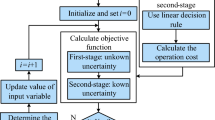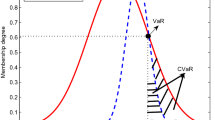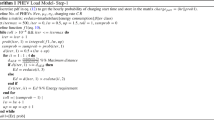Abstract
With the increasing penetration of renewable energy, uncertainty has become the main challenge of power systems operation. Fortunately, system operators could deal with the uncertainty by adopting stochastic optimization (SO), robust optimization (RO) and distributionally robust optimization (DRO). However, choosing a good decision takes much experience, which can be difficult when system operators are inexperienced or there are staff shortages. In this paper, a decision-making approach containing robotic assistance is proposed. First, advanced clustering and reduction methods are used to obtain the scenarios of renewable generation, thus constructing a scenario-based ambiguity set of distributionally robust unit commitment (DR-UC). Second, a DR-UC model is built according to the above time-series ambiguity set, which is solved by a hybrid algorithm containing improved particle swarm optimization (IPSO) and mathematical solver. Third, the above model and solution algorithm are imported into robots that assist in decision making. Finally, the validity of this research is demonstrated by a series of experiments on two IEEE test systems.
Similar content being viewed by others
Avoid common mistakes on your manuscript.
1 Introduction
The target of unit commitment (UC) is to reduce the operation cost of power systems while ensuring high power supply reliability (Egbue et al., 2022). For many years, UC has been regarded as one of the most important control process of power systems. Nowadays, with the concern of environmental issues, renewable energy generation has received great attention. For example, the wind power installed capacity in China has reached 26GW in 2019, accounting for 44 percent of newly installed global capacity (Zhu et al., 2022). However, renewable generation like wind power and photovoltaic (PV) power usually shows strong intermittence and randomness, which brings significant uncertainty and challenge to the economic and reliable operation of power systems (Yuan et al., 2021).
In order to solve the above problem, scholars mainly use point forecast, interval forecast, probabilistic forecast and scenario generation to handle the uncertainty of renewable power, and adopt stochastic optimization (SO) and robust optimization (RO) to solve the UC problem. Stochastic unit commitment (SUC) takes numerous possibilities of uncertain information into account, and the solution aims to make the overall performance of the objective function best under various scenarios. Liu et al. proposed a SUC model for electric-gas coupling system and used the improved progressive hedging (PH) algorithm to accelerate the optimization of SUC (2021) (Liu et al., 2021). Asensio et al. added a CVaR constraint to the traditional SUC model to effectively quantify risks and make reasonable decisions according to risks (2016) (Asensio & Contreras, 2016).
Generally, SO can reduce the cost of power generation on the premise of improving the reliability of system operation, but it may not guarantee system reliability under extreme situation, which makes the risk of SUC solution difficult to measure. Therefore, RO is introduced as a better way to alleviate the above shortcomings. Based on the analysis of power systems under various uncertainties, the UC schedule generated by RO performs well in the worst case (Chen et al., 2022). In the literature (Gupta & Anderson, 2019), robust unit commitment (RUC) method based on the feature sorting algorithm used in the traditional pattern recognition problem was proposed, which is flexible on the basis of considering all cases. Lee et al. considered both unit and transmission line failure rates, then used N-K criterion to establish a generation cost minimization model in the worst scenario (Lee et al., 2015). However, RO tends to pay more attention on low probability events, making the generated schedule too conservative (Lin et al., 2021).
By contrast, distributionally robust optimization (DRO) combines the characteristics of SO and RO, and has attracted great attention in recent years (Bian et al., \(\underline {P}_{g}(\overline {P}_{g})\)
Minimum (maximum) generation bound
\(R_{g}^{+}(R_{g}^{-})\)
Upward (downward) reserve capacity
Wj
Wind power capacity
\(W_{jt\omega }^{*}\)
Wind power production in scenario ω
\(\hat {f}_{l}\)
Day-ahead network power flows
Fl
Transmission capacity limits
D
Ambiguity set
B. Variables
ugt
On/off status of unit g at hour t
ygt
Status indicator of unit g at hour t for the startup process
zgt
Status indicator of unit g at hour t for the shutdown process
pgt
Setting value of power output by unit g at hour t
\(r_{gt}^{+}(r_{gt}^{-})\)
Amount of upward (downward) reserve capacity of unit g at hour t
ωjt
Wind power dispatch under scenario j at hour t
\(\hat {f}_{lt}\)
Network power flows
\(\hat {f}_{lt\omega }\)
Real-time power flows
\(p_{gt\omega }^{+}\)
Upward reserves of unit g at hour t under scenario ω
\(p_{gt\omega }^{-}\)
Downward reserves of unit g at hour t under scenario ω
\(\omega _{jt\omega }^{spill}\)
Amount of wind power production under scenario ω at hour t
\(l_{nt\omega }^{shed}\)
Allowable load shedding at each node
Compared with the specific probability distribution function, the moment information is easier to obtain. For instance, Zhang et al. constructed an ambiguity set based on moment information of wind power uncertain variable (2019) (Zhang et al., 2019). However, because different random variables may have the same statistical moment, the ambiguity sets based on statistical moment may contain probability distributions that deviate greatly from the empirical distribution. By contrast, distance-based method is more widely used in DRO UC. Essentially, the distance method first obtains the empirical probability distribution of random variables based on historical data, and then constructs the ambiguity set by defining the distance between other probability distributions and the empirical distribution. Therefore, the measurement of distance and the boundary of ambiguity set are two important parts of the distance method. In existing studies, norm and Kullback-Leibler (KL) divergence are commonly used distance measurement functions, and the boundary is usually selected according to a given formula or expert experience. For example, Ding et al. used the 1 norm and infinite norm to measure the distance, and obtained the boundary of the proposed ambiguity set according to certain formula (2019) (Ding et al., 2019). Chen et al. constructed an ambiguity set based on KL divergence, and the boundary was selected according to the experience of decision makers (2018) (Chen et al., 2018).
Although the above studies provide promising ways to solve DRO UC, all the ambiguity sets were constructed under a single time horizon, which ignores the time series features of uncertain information over the scheduling horizons. By contrast, renewable generation scenarios contain spatial-temporal correlation, therefore some scholars have also carried out relevant studies. For an instance, Zhang et al. screened historical data according to real-time information, then obtained a series of scenarios through clustering and constructed ambiguity set based on the 1-norm and the infinite norm (2021) (Zhang et al., 2021). Nonetheless, the construction methods based on norm only assume that the probability value of each scenario is variable. Considering the strong randomness of renewable generation and the limitation of historical data, there will also be some error in the power generation of each period in each scenario. Besides, in the face of different data sets, many existing studies use the same formula to obtain the boundary of ambiguity sets, which makes the effectiveness and objectivity of such methods questionable. Therefore, constructing time series ambiguity sets based on scenarios still has a lot of room for improvement.
Apart from constructing ambiguity sets, the solution methods of DRO UC is also significant. In order to solve the DRO problem, many scholars employ mathematical optimization methods that transform the infinite dimensional subproblems in the model based on linear decision programming and duality theory, then use mathematical solvers to handle the main problem and subproblems repeatedly. For example, a DRO framework of an electric-gas coupling system was proposed in Sayed et al. (2021), and at the same time, the model was solved by using nested columns and constraint generation algorithm. Liang et al. proposed an alternate iteration method based on bender decomposition to solve a min-max bi-level DRO model (2022) (Liang et al., 2022). Although mathematical solvers can guarantee the solution optimality, the model transformation process is rather complicated, and sometimes impossible to achieve. Besides, the use of linear decision rules in the transformation process may also make the solution deviate from the original model.
In addition, system operators need to evaluate and select UC decision, which often requires much experience and makes scheme selection highly subjective. Especially in some new energy power plants in bad environment, system operators can not be stationed in large numbers. Nowadays, the rapid development of robots has brought great convenience and help to many aspects of people’s life. Some tasks that require precision or are dangerous can be assisted by robots. Chen et al. used robots to explore unknown environments based on deep learning (2022) (Chen et al., 2022). Besides, artificial intelligence plays an important role in fighting the COVID-19 pandemic, including robotic assistance in isolation area (Piccialli et al., 2021). However, there is still much room for robotic assistance in the field of renewable energy generation.
Therefore, to mitigate the above defects, this paper proposes a scenario-based distributionally robust unit commitment (S-DR-UC) model handled by an improved hybrid solution algorithm, which contains robotic assistance. Specifically, this study firstly conducts clustering, classification and scenario reduction on the collected actual renewable power data and point forecast renewable power data to obtain the empirical distribution of ambiguity set. Then, the historical distribution method (Jabr, 2020) and bootstrap method (Luo et al., 2019) are used to get the boundary of the ambiguity set. After that, a S-DR-UC model based on the time series ambiguity set is established, and a hybrid solution algorithm containing improved particle swarm optimization (PSO), mathematical solver and parallel computing is designed to handle the complicated nonlinear S-DR-UC model, which are imported into robots that assist in decision making. Therefore, the contributions of this study can be summarized as follows:
-
(1)
Scenario-based ambiguity set: Compared with existing studies, scenario can better integrate the temporal correlation between uncertain information and directly serve the optimization scheduling of power systems. In addition, by using the historical method and bootstrap method, the scenario-based ambiguity set proposed in this study is more comprehensive in considering uncertainty, and more objective in setting the boundary of ambiguity sets.
-
(2)
Improved PSO: Compared with classical PSO, cosine similarity is introduced to measure the similarity between empirical distributions for temporal ambiguity set, thus dynamically adjusts weight to mitigates the local convergence problem.
-
(3)
An improved hybrid solution algorithm for S-DR-UC model: A novel algorithm containing PSO, mathematical solver and parallel computing is designed to handle S-DR-UC model. Compared with existing studies, our algorithm avoids complex transformations and conduces to assure the physical meaning of the original model. Besides, our method can achieve a satisfied solution of the model within an acceptable runtime cost.
-
(4)
Robotic assistance: Compared with the traditional UC decision for prediction results, this study introduces robots into the decision-making process. By importing models and algorithms into multiple robots, hel** to reduce the subjectivity of scheme selection.
The rest of the paper is arranged as follows: Section 2 explains the way to construct the scenario-based ambiguity set. Section 3 provides the S-DR-UC formulation which includes the objective function and constraints considered. Section 4 introduces the hybrid solution algorithm which integrates an improved PSO, mathematical solver and parallel computing. In Section 5, the effectiveness of the research is justified on modified IEEE RTS-96 and RTS-24 systems. Finally, Section 6 concludes the work.












